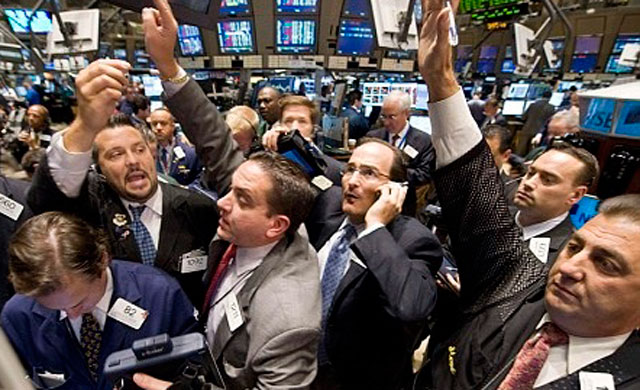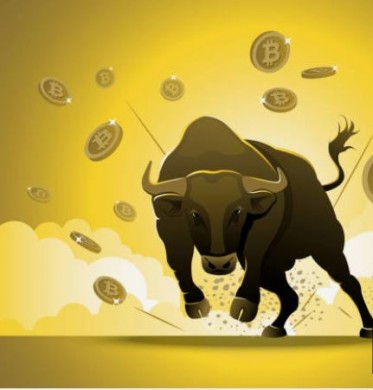The BTI, a sentiment indicator, turned down on 10 June and is still declining. But on Monday it was up, sentiment is changing from bearish to bullish. When sentiment is bullish odds favour a stock market rally. I expect sentiment to turn bullish in the next few days but sentiment will only be bullish if the “remain” camp wins the referendum. In the event of a “leave” win the stock market will plummet, the drop could be between 10%-15%.

Meanwhile the FTSE 100 extended its rally to 6300 today and in the process created a five-wave pattern. A five-wave rally is an Elliott wave pattern depicting an uptrend. The question is: why would the stock market turn up ahead of the referendum vote? After all the results are too close to call, according to the polls. The answer is probably found in the way investors behave. If the majority of investors believe that “remain” will win, they will buy stocks ahead of the referendum and that is what is happening now. We get into a situation where Britain remaining in the EU is priced in.
Yet for some reason, the S&P 500 is not confirming the position of the FTSE, the trend in the S&P appears to be down. So we have a conflict between the two indexes, when the two indexes do not confirm each other one of the wave counts is wrong. Right now it’s impossible to say which wave count is wrong. In their speeches yesterday both Fed chair Janet Yellen and ECB president Mario Draghi said it would be very hard to predict the economic impact of leaving the EU but it would be felt globally. On the positive, Brexit would delay any rise in US interest rates. However, George Soros, the well known currency speculator, warned that Brexit would cause a bigger and more disruptive devaluation of the pound than the 15% devaluation that occurred in 1992.
This of course would kick start a series of events starting with company failures. A weaker pound means margins at UK importers would shrink, and considering that British trade with the EU is much larger than with anyone else, a large number of companies would no longer be competitive and may be forced to close down. For the consumers imported goods would become more expensive. For investors, foreign investors would liquidate their assets by selling shares and property and move money abroad. This would add more pressure on the declining stock market. A best case scenario is a 10%-15% drop in stocks, the worst case scenario would be a crash. Note that in the event of a crash or a severe stock market correction, the economy would contract as consumers would cut spending. Let’s not forget the 1929 crash caused a depression in the US. As you can see a sharp drop in the pound is the real danger, and no one really knows what will happen in the long term.
As I said the first sign of a stock market advance is when the Elliott wave pattern unfolds in five waves. Elliott wave analysis is a detailed description of how groups of people behave. It reveals that mass psychology swings from pessimism to optimism and back in a natural sequence, creating specific and measurable patterns. One of the easiest places to see this phenomenon at work is in the financial markets, where changing investor psychology is recorded in the form of price movements. As I said a rally in five waves indicates that the trend is up.

On the daily chart wave i (circle) which is the current rally is in five waves. To see the five waves you need to zoom in on the move by selecting a 30-min chart. From the top on 21 April [wave C], the index declined to 5900 in three waves [a,b,c (circle)]. This move could be wave X of an upward double zigzag [A,B,C,X,A,B,C]. If the decline to 5900 was the first wave of a five-wave decline as previously thought, the rally from 5900 would be in three waves. Well, that’s not the case, the rally is in five waves. Therefore, I believe the dip to 5900 was a pause in the uptrend, this uptrend is still in place and the current rally is wave i (circle). The next move is wave ii (circle) down, this partial retracement could end between 6100-6200. Thereafter I expect the rally to resume with wave iii (circle) up.
The sequence [i,ii,iii,iv,v (circle)] will be wave A of the second upward zigzag [A,B,C] and the target is 6600. If wave ii (circle) down unfolds tomorrow, the next move up which is wave iii (circle) will occur on Friday and will coincide with the results of the referendum. The market won’t go up if we leave, therefore the Elliott wave suggest a victory for “Remain”. Please remember this is based on probabilities, there is no certainty in the stock market.
Thierry Laduguie is Trading Strategist at www-e-yield.com


 Hot Features
Hot Features














hi,
Very good post and I’ve been following your post for a while now! Last few months you mentioned we are in a bear market with UK following the way? What happened to that idea! Are we now out of a bear market? Where we ever in a bear market in the first place?